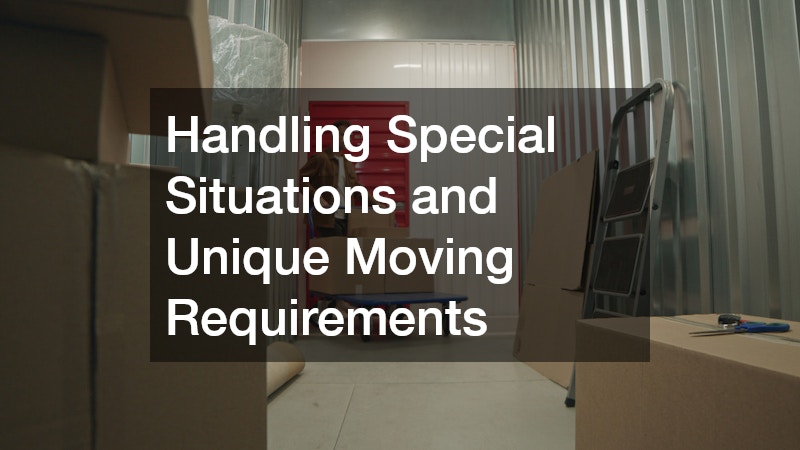Relocating to a new home or workspace can feel overwhelming, especially when planning, packing, transporting, and settling in all seem to happen at once. From sorting through belongings to coordinating schedules and handling logistics, many moving parts require attention and organization. Yet, with the right strategy and mindset, the experience does not have to be defined by stress. A successful move comes down to preparation, thoughtful decision-making, and the ability to break the process into manageable steps. When approached with clarity and structure, your next move can become an opportunity for renewal, efficiency, and even enjoyment. This guide will explore practical steps to help reduce stress, improve organization, and ensure a smooth transition from start to finish, offering a clear path toward a more seamless moving experience.
Planning for a Smooth Transition
Early preparation is the cornerstone of a well-managed move. When planning begins several weeks or even months in advance, there is time to evaluate furniture needs, determine what to keep or discard, and research professional help where needed. This is where moving simplified begins: with acknowledging that rushing leads to chaos, while planning leads to control. Start by identifying your moving timeline and working backward. Determine the final move-out date and assign tasks to specific days or weeks leading up to it. Create a checklist that covers packing supplies, utility transfers, change-of-address notifications, and cleaning schedules.
It is equally important to declutter before the move. Instead of transporting items you no longer need, consider donating, recycling, or responsibly disposing of them. For large purges during staging or cleanup, using local dumpster rental services can be an effective way to manage excess household waste. Clearing out unused belongings not only reduces moving weight but also brings clarity and peace during a time of transition.
Communication also plays a vital role. If others are moving with you, make sure responsibilities are clearly divided. If pets or children are involved, create a plan for their care on moving day to avoid unnecessary distractions or stress. The more decisions made in advance, the smoother the experience will be. Another occurrence of moving simplified can be seen here in the ability to create order where disorder might otherwise appear. Planning is not simply a precursor to action; it is the guiding framework that supports every element of the move. By approaching the process thoughtfully—rather than reactively—you set the stage for a move defined by efficiency instead of anxiety.

Choosing the Right Professional Support
Selecting qualified professionals can dramatically shape the quality of your moving experience, particularly when traveling long distances or transporting valuable items. This is where the principle of moving simplified continues to play out through outsourcing challenging tasks to specialists. Researching and comparing options ensures you choose a team that aligns with your budget, timeline, and expectations. Factors such as reputation, insurance, scheduling flexibility, and scope of services should all be evaluated carefully.
For cross-state or cross-country relocations, long distance movers can reduce both physical strain and logistical difficulty. These professionals are equipped to handle planning, packing, loading, transport, and unloading in ways that protect your belongings while maintaining efficiency. Ask for estimates from multiple companies and verify what services are included. Transparency is essential; a reliable company will answer questions clearly and provide details in writing.
Some movers also offer customized solutions for unique needs, such as fragile item care, temporary storage, or vehicle transport. This is especially valuable if you have antiques, artwork, or unusual equipment that require specialized handling. Another instance of moving simplified appears here in the value of trusting experienced professionals. Instead of struggling to coordinate every detail alone, you gain partnership and reliability.
Finally, communication is crucial when selecting the right support. The more open the dialogue, the more aligned expectations will be. A positive working relationship reduces misunderstandings and builds confidence in the move. Professional assistance is not simply a convenience—it is a strategic investment in the outcome of your relocation.
Packing with Purpose and Efficiency
Packing can easily become one of the most time-consuming aspects of a move, but a smart approach ensures this step supports the theme of moving simplified rather than complicating it. The key is to pack with purpose rather than rushing to place items into boxes without thought. Begin with non-essential items and seasonal belongings, working toward everyday essentials closer to the move-out date. This phased approach reduces disruption in your daily routine.
Labeling is an essential component of an efficient packing process. Each box should include not only its contents but the room it belongs to in the new space. This saves significant time during unloading and unpacking. Color coding, numbering systems, or room-based sorting can streamline organization even further. This is also a good stage to involve professional moving services if you prefer not to pack fragile, heavy, or valuable items yourself. Many moving companies offer full-service packing support, including specialty materials for delicate possessions.
Creating an essentials box is another critical step. This box should include items you will need immediately upon arrival—such as toiletries, chargers, medication, paperwork, tools, snacks, and basic kitchen items. Having these essentials accessible prevents the frustration of sorting through dozens of boxes before you can settle in. This step represents another meaningful demonstration of moving simplified, where foresight saves both time and stress.
Finally, take photographs of electronic setups or complex furniture assembly before disassembly. These references will be helpful later when setting up your new space. Packing is not simply a task to complete—it is a method of preparing your environment for a smooth transition.

Selecting the Right Moving Company for Your Needs
Hiring local moving company can make a significant difference in how efficient and pleasant your moving experience becomes. Companies vary widely in pricing models, service offerings, equipment, and customer service philosophy. To stay aligned with the idea of moving simplified, research should include customer testimonials, insurance coverage, safety practices, and clarity of estimates. Transparent communication reduces the likelihood of unexpected fees or misunderstandings.
Schedule in-home or virtual assessments before agreeing to a contract, as accurate quotes depend on an understanding of volume and access conditions. Staircases, elevators, narrow hallways, and driveway space can influence time and labor requirements. Providing full information upfront ensures fair pricing and smoother planning.
An essential aspect of choosing the right company is matching service level to your needs. Some moves require only loading and unloading assistance, while others involve complete packing, transport, unpacking, and even furniture assembly. The more comprehensive the support, the more your experience reflects moving simplified in practice.
Don’t hesitate to ask questions before finalizing your decision. Trust, reliability, and professionalism are just as valuable as cost. Ultimately, the moving company you choose becomes a partner in one of the most significant transitions you will make.
Preparing Your Home and Property for Move-Out
Before moving day arrives, ensuring your current home is prepared can prevent unexpected complications. Cleaning, repairs, and maintenance steps not only help you leave the property in good condition but also reduce delays and distractions during the move. An instance of moving simplified can be seen in the thoughtful preparation of both interior and exterior spaces.
For homes with fireplaces or wood-burning heating features, scheduling chimney cleaning companies can help ensure your property is safely maintained before new occupants arrive. This step is often overlooked but can be important when selling or turning over a rental home.
You should also check flooring, walls, and doors for items that need patching or polishing. The goal is to leave the home clean, safe, and ready for the next person. If you will be staging your home for sale or walkthroughs, clearing excess furniture and décor can help make the space feel more open. This is where a second instance of moving simplified becomes evident, as decluttering leads to faster packing and less crowded moving pathways.
Outdoors, check that driveways, entryways, porches, and stairwells are clear of ice, debris, or obstructions. This reduces the risk of injury while movers carry heavy items. Preparing the property ensures moving day can proceed efficiently and safely. Consider looking into car towing services to transport your vehicles or heavy equipment to your new space.
Additionally, consider scheduling a final deep cleaning or hiring a professional cleaning service to ensure the space is left in excellent condition. Take time to address minor repairs such as replacing light bulbs, tightening loose handles, or touching up scuffed paint. If renting, review your lease requirements to avoid unexpected charges and take photos of each room once it is emptied to document its condition. Finally, ensure utilities are scheduled for transfer or shut-off on appropriate dates to avoid service disruptions or unnecessary billing.

Handling Special Situations and Unique Moving Requirements
Some moves involve temporary facilities, event relocations, on-site work teams, or transitions that require extra accommodation. In these scenarios, moving simplified means anticipating special conditions and preparing solutions ahead of time. For example, construction projects, outdoor events, or rural property moves may require access to a portable restroom trailer to maintain convenience throughout the process. These facilities can provide sanitation support when plumbing access is limited.
Moves that require storage should also consider the type of environment that best protects belongings. If you are moving musical instruments, artwork, sensitive documents, wooden furniture, or electronics, it may be wise to secure climate controlled storage units to protect these items from humidity and temperature fluctuations.
Another way moving simplified applies here is by preparing for temporary or partial moves. Sometimes belongings need to be transported in stages rather than all at once. Temporary equipment, cargo van rental, provides flexibility for small loads, staggered pickups, or DIY moves. Similarly, if transporting items in a personal vehicle or pickup truck, installing truck bed covers can protect items from weather exposure and road debris.
The key to handling unique situations is proactive planning and logistical creativity. The more prepared you are for special requirements, the more seamless your overall moving experience will feel.
Settling Into Your New Space with Intention
Unpacking is often where excitement meets exhaustion, but approaching settlement with intention ties back to the principle of moving simplified and encourages a positive start in your new environment. Instead of opening every box at once, begin by setting up beds, bathrooms, and the kitchen. Establishing functional spaces early allows you to live comfortably while continuing to unpack at your own pace.
Arrange furniture before unpacking decor and smaller items. When the large pieces are placed first, flow and layout become clearer. After the essential spaces are functional, unpack room-by-room rather than jumping between areas. Focus prevents the feeling of being spread too thin.
Take time to familiarize yourself with your new surroundings. Locate circuit panels, water shut-off valves, and HVAC controls. Update mailing addresses and reconnect services if necessary. Introduce yourself to neighbors when possible, as strong community connections contribute to long-term satisfaction and ease.
Finally, express patience with yourself during this adjustment period. A new space becomes a home through time, familiarity, and personal touches. The last instances of moving simplified appear here not as a strategy but as a mindset: embracing change gradually, with confidence that order and comfort will settle in.

Final Thoughts on a Stress-Free Move
Every move represents a fresh start—a new chapter with new opportunities. When approached with planning, awareness, and support, a move does not need to be defined by stress or overwhelm. It is possible to maintain clarity, confidence, and calm from the first day of preparation to the final moment of settling in. The core concept of simplifying the moving process lies in thoughtful organization, smart decision-making, and the willingness to seek help where needed.
Through planning, professional support, strategic packing, thoughtful property preparation, and mindful settling-in, you can transform your next move into an organized and positive experience. The goal is not to eliminate every challenge, but to structure the process in a way that is manageable, intentional, and uplifting.
Your transition can be smooth. Your moving experience can be empowering. Your next chapter can begin with clarity.
Your journey toward moving simplified begins with a single intentional step.



